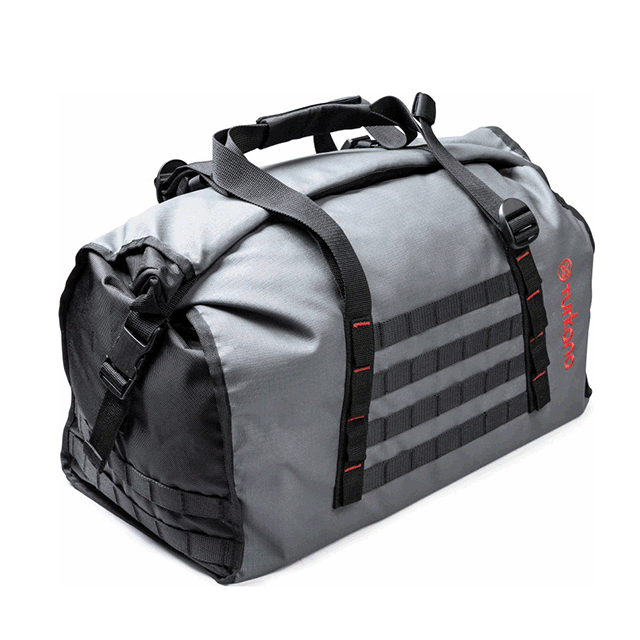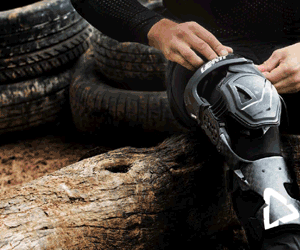“Difficult experiences on the road, even the ugly ones, are perhaps those that teach you the most. For example, on a particular trip to Cappadocia in Turkey, I had some tremendous experiences riding through storms in the middle of nowhere. I was crossing the border between Montenegro and Bosnia in a terrible rainstorm at night, lost without navigation and almost out of petrol. Now I remember that adventure as one of the most beautiful experiences I’ve had. If all goes well, you are probably not learning anything.” – Filippo Barbacane

Filippo has been building custom motorcycles since 1993. “I am self-taught because in Italy there was nothing like that in those years. There was a small Harley scene, but in reality, customizing was non-existent. So I had to start from scratch. My first workshop was called Firestarter Garage, and I had a store selling accessories and clothing, but then I realized that my path was to build bikes. I understood the work, and it contained the most beautiful things in the world to me. To create a moving piece of art through craftsmanship is a true expression of creativity for me.” Filippo also prefers to work alone on his projects. “In my workshop, there is only me. I do have external collaborators that I use for covering saddles and for painting; however the rest I do myself. It’s essential for me to build my bikes completely on my own. It always makes me laugh when workshops consider themselves builders, but then practically they just outsource everything to outsiders. I find it ridiculous, that basically means that you are an entrepreneur and not a builder.”

Officine Rossopuro is Filippo’s workshop and his second home. “To me, it represents a cross-section of Italian craftsmanship that builds, designs and creates. Us Italians are still great at that!” But the spark for this passion started in 1991 when Filippo got his first motorcycle in the form of an enduro, and from there “something just took off” inside of him. “It wasn’t a rational thing, something that you can’t explain, something that goes beyond pleasure or wanting to ride, but a duty to ride. It is a physical and psychic need. To ride is a meditative process for me.” There are also moments riding that he considers enlightened in the Buddhist sense of the term. “I am a great fan of Japan, and it’s culture where I’ve often traveled on a motorcycle. I read a lot about oriental philosophy, and I sometimes get the momentary impression, while I’m moving, that I’m reaching a kind of nirvana. Moments when you laugh in the helmet, a kind of euphoric heat that pervades you from inside. You can’t explain it but only those who’ve experienced it will know it.”

For Filippo his entanglement with Moto Guzzi can be summed up in one word; love. “It’s the same as when you try to make your friends understand that you like a woman, however, they don’t seem to understand. You try to tell them that even if there are problems, flaws, you still love her, but they say it’s not good. They don’t understand no matter how much you end up explaining it. This happened to me with Moto Guzzi. I don’t have a logical explanation; it happened because it had to happen.” However, he also considers himself a motorcyclist without prejudice. “There are no brands that I hate as I often hear someone say. I find it very sad because I love all bikes and I respect all the brands. Guzzi, however, has something special for me, and I will always have it even if I work on other brands willingly.”

“The GranSasso 1100 is my ideal bike or more correctly my definitive bike, that is until I get some other strange or maybe more definitive “nightmares” to engage myself with. I’ve been thinking about this project for the last two years, but I couldn’t find the time to put my hands on it. The only thing I knew was the name, GranSasso. It’s the highest mountain in my region of Abruzzo, Italy, and one of the most beautiful places in the world. I had the good fortune to summit it once. It’s the mountain you see in the photos” Filippo wanted to build a bike that was versatile, practical, but also had style and represented the capacity of his creativity and craftsmanship. “I use to ride a dual purpose Stelvio 1200 with which I traveled long and wide through Europe riding over 62 000 mi / 100 000 km. It’s an exceptional bike, but there was a couple of things that I wanted to change.” First up was the weight which in Filipo’s mind is the most important part of designing a motorcycle. “I do not care much for horsepower. I prefer a lighter motorcycle to a more powerful bike. Besides, the Stelvio’s engine runs hot and has a lot of mechanical noise, as well as many more mechanical parts that make it more complex and heavy. So the perfect bike for me would be a lighter Stelvio, with a 2V engine and some unique aesthetics.”

So Filippo sourced a Stelvio chassis and a V2 1100cc engine from a Breva. “This is the best engine of all time in my opinion. It combines all the features typical of the older Guzzi’s along with the best traits of the new ones. It has a unique mechanical and electronic simplicity, but with absolute reliability. I’m not a proponent of all the modern trappings found in newer models.” First order of business was cleaning the frame of all unessential parts making it lighter. “I removed the rear frame that was welded to the main frame; this enabled me to fabricate a removable chrome molybdenum steel subframe.” For suspension, a set of 50mm Marzocchi adjustable forks up front and a specially build Extreme Tech rear shock made for this bike got fitted. Alpina tubeless spoked wheels with a 19” front and a 17” rear are shod with Continental TKC70’s. “Once I’d put the bike on its feet I worked on designing a functional body that was specifically designed and made for me.” This meant that the original geometry of Filippo’s much tested Stelvio was left alone while he focused on other aspects of the build. Fuel range is always a consideration with adventure bikes, so the construction of a large aluminum tank to tackle those long journeys was critical. “I built a central fuel reservoir with two side covers that in case of a fall could be replaced. This insured that the fuel tank would be protected. In addition, I also fabricated carbon covers that could house tools or spare parts along with any other accessories I might choose.”

“The rear frame can be easily dismantled along with the electrical system that is connected via quick plugs. Below this, I installed a purpose built airbox and a lightweight lithium battery.” The seat pan is also in aluminum number that features a quick release and a height adjuster. “The aluminum back seat cover can be replaced by a passenger seat or a rear bag. Inside there is a rain suit and a toolkit is also stored under the saddle.” The front aluminum fairing, also made by hand, is adjustable. A high plexiglass version for long journeys also being available. To easily replace the main headlight bulb Filippo opted not to install an LED set-up. “It’s also much lighter than a reliable LED unit. For the same reason, I installed a rear light with a two light configuration. One LED and one with a traditional bulb. In addition, there are two additional low-voltage LED spotlights fitted up front just above the headers. “The aluminum footrests was also fabricated in-house and are adjustable, along with the aluminum risers and the cardan reaction shaft.” Opting not to install radial brake pumps, Filippo went a more straightforward route to avoid fitting an external oil tank and therefore creating a potential mechanical vulnerability when out exploring.

The front beak is made out of plastic with an aluminum tip that helps avoid breakage along with guaranteeing safety in the event of a collision. “Even the aluminum engine guard was specifically tailored to fit the design of the GranSasso.” Hand-guards and fork guards are also provided for off-road use, as well as removable frames for mounting both soft and aluminum panniers. The exhaust was manufactured by MASS from steel based on Filippo’s design and is an officially approved item. “The total running weight of the bike is 198 kg, which makes it an exceptional bike to handle. I’ve had the chance to try hundreds of bikes, but I must say that driving the GranSasso is incredible. The bike has an exceptional dynamic and commits to curves with crazy agility. Combining the chassis of the Stelvio with a weight drop of around 154 lbs / 70 kgs has not only created a visually pleasing motorcycle but also one that has proved itself to be extremely capable. Both on and off-road. “I could have used other even lighter and more costly materials, but I wanted a bike that would be easy to repair with simple means far from home. The whole machine can now be easily disassembled with only a few hand tools.”

“For me, the key to being successful when building a motorcycle is the balance between your craft and creativity. If you are good with your hands, but you have no ideas, you won’t get far. The same if you have great ideas, but you can’t put them into practice. It’s the alchemy of both that makes the difference. In the industry, there are what I like to call meteors or passing characters that become fashionable. These builders become famous thanks to the media who always need something to talk about. However, it’s time itself that will be the deciding factor. Only time rewards work and in the end, only those who genuinely have great passion and skill remain.

“I have a huge amount of projects in mind, I have hundreds of ideas, and I probably won’t be able to build all of them. At the moment I’ve been pretty busy since the birth of twin sons. Yes, twins just as the engine from a Guzzi. I hope that maybe they’ll carry on my ideas one day. For now, I’m just planning on building and creating more motorcycles. I’d do it anyway, even if I lived in the middle of a forest alone and nobody knew about it!”
Stationary photos are by Filippo Barbacane with riding imagery of Filippo in action shot by Andrea Tomassetti.





Leave a Reply